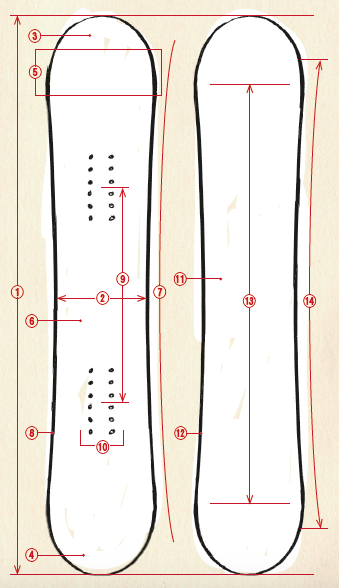① Overall length
Snowboard length.Generally, it represents the maximum length that connects straight from the tip of the nose to the tip of the tail.Since there is also a "sole length" that is measured by applying a tape measure along the sole, it is sometimes called a "silhouette length" in the sense that it has the same length as the shadow cast on the ground.
② Waist width
The thinnest part of the snowboard.Depending on the balance with the side curve, if it is thin, the turn will be lighter, and if it is thick, it will be stable at the landing of the jump.Since a difference of a few millimeters makes a big difference in operability, in the case of beginners, it is a part that should be emphasized rather than the total length.
③ Nose
The tip of the snowboard in the direction of travel.Normally, it is thin so that it will not get caught in the snow, and it is greatly warped.This warped part is called a locker.The trendy rocker board is named because this rocker part is long.
④ Tail
The rear end of the snowboard.It is thin and has a locker so that it can slide even with a fakie.For freeride-focused boards, the tail rocker is smaller than the nose, and for trick-focused boards, the nose and tail are given the same level of rocker.
⑤ Shoulder
The thickest part of the snowboard.The size of the board greatly affects the turning characteristics of the first half of the turn because it is the part that comes into contact with the snow first on the turn when the board is erected.If the shoulder width of the tail is narrower than the shoulder width of the nose, it is called "tapered".
⑥ Deck
The side to attach the snowboard binding.
⑧ Side wall
The side part of the snowboard.The materials and manufacturing methods have been devised in detail, which has a great impact on the flex and torsion of snowboards.
⑨ Stance width
The opening width of both feet when attaching the binding.Measure the distance between the center of the binding disc.
⑩ ?? Insert
A female screw embedded in a snowboard to screw the binding.Correctly "insert screw"
⑪ Sole
The side of the snowboard that comes in contact with the snow.
⑫ Edge
A metal rail provided on the outer circumference of the sole.Make turns easier by digging into snow and ice.Made primarily of iron, it can even wrap around the nose and tail to protect the snowboard itself.
⑬ Snow contact length
It shows the length of the sole that is in contact with the snow while going straight.Since it is the value of the part that is actually in contact with the snow, it is the most practical value when choosing the size.If it is long, it is stable, and if it is short, it can move lightly.Sometimes called running length.
⑭ Effective edge
The length of the edge along the side curve from shoulder to shoulder.It shows how long the edge touches the snow during the turn. The longer it is, the more stable the turn is, and the shorter it is, the lighter the operability.
⑦ Side curve
The constricted part of the snowboard.It is an arc, and the radius of this arc is called the "side curve radius".The smaller the side curve radius is, the more suitable for a quick short turn, and the larger the side curve radius is suitable for a loose long turn.
⑮ Locker
The part that is warped when the snowboard is placed on a flat surface.On the camber board, the only rockers are the nose and tail.The reason why the whole board is warped is called "rocker board" because the whole sole is rocker-shaped.
● Core
The base part that supports the structure of the snowboard.Most snowboard cores are made of wood and are called "wood cores".
● Concave
When the snowboard is turned over and the sole is turned up, the center of the sole is dented like a half pipe.The dents are negligible and many are not noticeable to the eye.Since the edge is pressed against the snow surface more strongly than the sliding surface, the edge bites better.
● Convex
When the snowboard is turned over and the sole is turned up, the central part of the sole is protruding like a kamaboko.The bulge is very small, and many of them are not noticeable by the eye.Since the sliding surface is pressed against the snow surface more strongly than the edge, the operability becomes lighter.
● Setback
The difference between the center of the snow contact length and the center before and after the stance width.The one where the center of the snow contact length and the center of the stance width match is called "setback = zero", and the larger the setback, the closer the stance is to the tail side.The standard setback is about 1 inch (2.5 cm).











